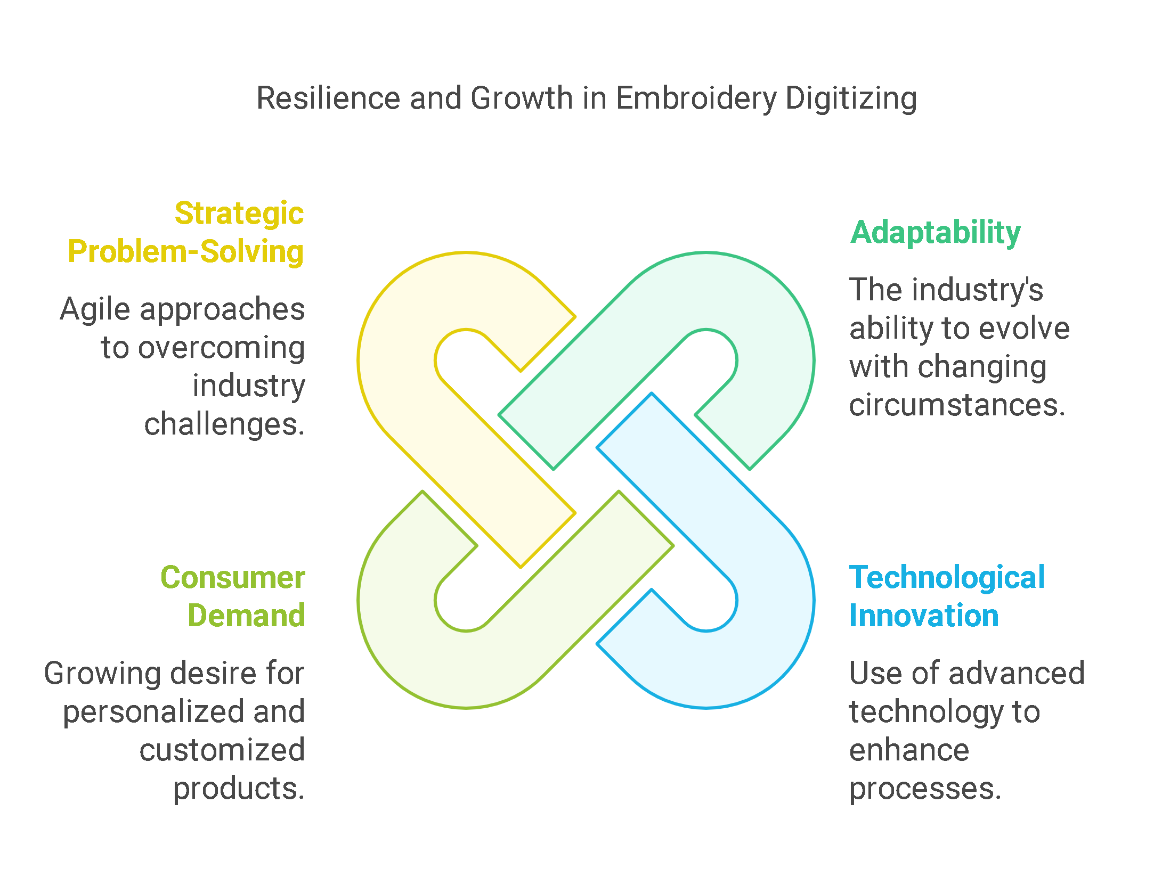Have you ever paused to think about the intricate embroidery designs you see on branded apparel, custom gifts, or corporate uniforms? What if I told you that behind every one of those perfectly stitched patterns lies a fascinating process called embroidery digitizing—the bridge between creativity and technology?
Embroidery digitizing is the unsung hero of the customization world, converting your imaginative designs into precise, machine-readable formats for embroidery. It’s what turns a simple logo or artwork into a vibrant, textured masterpiece.
But let’s face it—no industry thrives without challenges. Over the years, the embroidery digitizing industry has faced its fair share of obstacles: economic downturns, rapid technological shifts, and even a global pandemic. Yet, it continues to thrive and evolve, proving its resilience and relevance in today’s fast-paced, consumer-driven world.
In this blog, we’ll take you on a deep dive into the world of embroidery digitizing—its journey, its resilience, and the exciting ways it’s shaping the future of customization.
So, without any ado, let’s get started…
Every great industry tells a story of resilience—and embroidery digitizing is no exception. What makes this sector stand out is its ability to adapt, innovate, and flourish even in the face of economic uncertainties, technological disruptions, and shifting consumer demands.
The embroidery digitizing industry has faced its share of hurdles. From economic downturns that tested budgets to global supply chain disruptions that made sourcing materials more difficult, businesses in this space have encountered challenges that could have brought weaker industries to their knees. Yet, embroidery digitizing has not only survived but continued to expand its reach and influence.
Take, for instance, the COVID-19 pandemic. While many industries struggled to stay afloat, embroidery digitizing discovered opportunities in the chaos:
The numbers tell a story of growth and potential. The embroidery digitizing market, currently valued at $3,167.70 million, is projected to grow to $8,071.96 million by 2032. What drives this incredible growth? A combination of technological innovation, consumer demand for customization, and the industry’s adaptability to meet new challenges head-on.
This resilience reflects not just survival, but a deeper ability to evolve with the times—proving that embroidery digitizing isn’t just a service; it’s a thriving ecosystem that supports businesses and individual creators alike.
What truly sets the embroidery digitizing industry apart is its adaptability:

Technology has been the linchpin of the embroidery digitizing industry’s success, streamlining processes, enhancing creativity, and delivering superior results.
Modern digitizing software allows for precise conversion of intricate designs into machine-readable formats. These tools enable:
Today’s embroidery machines are a testament to technological innovation, offering features that elevate the art of embroidery:
The e-commerce boom has transformed how embroidery digitizing service are delivered. Digital platforms allow businesses to:
Meeting consumer demands is critical for any industry, and embroidery digitizing is no exception. By focusing on personalization and sustainability, the industry has positioned itself as a preferred choice for both businesses and individuals.
Consumers today value products that reflect their individuality. Embroidery digitizing allows for:
Special Occasion Gifts: Tailored embroidery for weddings, birthdays, and other milestones.
As eco-conscious practices become a priority, embroidery digitizing offers a sustainable alternative to other customization methods:
No industry worth its success has achieved it without overcoming significant challenges, and embroidery digitizing is no exception. What sets this sector apart is not just its ability to face hurdles, but its ingenuity and strategic adaptability in overcoming them. The embroidery digitizing industry has consistently turned obstacles into opportunities, emerging stronger and more innovative with every challenge.
The embroidery digitizing industry, like many others, faced severe supply chain disruptions in recent years. From raw material shortages to rising costs due to geopolitical events, such as the Russia-Ukraine conflict, global crises tested the resilience of businesses in this space.
How the Industry Adapted:
These proactive steps not only helped stabilize operations but also positioned businesses to handle future supply chain fluctuations more effectively.
When the pandemic forced industries to adapt to remote work, embroidery digitizing faced a unique challenge: maintaining precision and quality while employees worked from home. This shift required quick thinking, technological upgrades, and a focus on training.
How the Industry Overcame It:
The result? Embroidery digitizing businesses not only sustained operations but also enhanced their productivity, proving the industry’s flexibility and resilience.
Economic downturns and inflationary pressures have led to increased costs for raw materials, labor, and transportation. This posed a significant challenge for embroidery digitizing businesses aiming to deliver quality services at competitive prices.
How the Industry Tackled It:
By focusing on efficiency and innovation, the industry managed to offset rising costs and remain competitive in a price-sensitive market.
The rapid pace of technological change is a double-edged sword. While it drives innovation, it also demands constant upgrades and investments—challenging businesses to stay relevant in an ever-evolving industry.
How the Industry Stayed Ahead:
The Embroidery digitizing industry continues to evolve, opportunities abound for businesses willing to innovate and adapt. With the integration of AI-driven tools, enhanced customer experiences, and a growing emphasis on sustainability, the future looks brighter than ever.